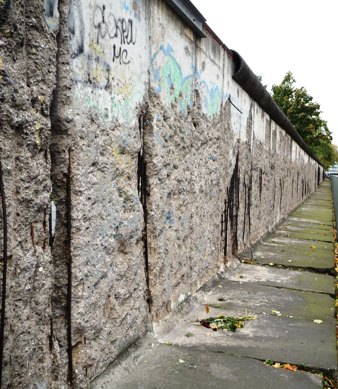I’ll admit it. When my Berlin-savvy friend asked if I’d like to stop by the Brandenburg Gate (Brandenburger Tor), I said “yes, of course!” As we strolled past the Hotel Aldon (of Michael Jackson fame), I racked my brain trying to think of what I remembered (or had ever learned) about the Brandenburg Gate and came up next to  empty. I guess this is the beauty of traveling- to discover new places and ideas and to educate ourselves about the historical and cultural significance of certain sites. Thankfully, my Berliner friends gave me a general overview of the Brandenburg Gate’s history as we stood in front of this impressive monument at the end of Unter den Linden (Berlin’s principle boulevard).
empty. I guess this is the beauty of traveling- to discover new places and ideas and to educate ourselves about the historical and cultural significance of certain sites. Thankfully, my Berliner friends gave me a general overview of the Brandenburg Gate’s history as we stood in front of this impressive monument at the end of Unter den Linden (Berlin’s principle boulevard).
When I got home, I felt compelled to learn more about this great German symbol of both division and unification. It is a former city gate, the only remaining one of several that were used as a formal entryway into Berlin in the late 18th, 19th and early 20th centuries. Originally constructed in 1791, the Brandenburg Gate was commissioned by Friedrich Wilhelm II and designed by Karl Gotthard Langhans.
 The gate was modeled after the Propylaea, the entrance hall of the Acropolis in Athens, Greece. The Propylaea was the gateway to a shrine of the ancient world; likewise, the Brandeburg Gate served as the passage into the most important city of the Prussian empire. The Brandenburg Gate is topped with a quadriga (a car or chariot drawn by four horses) carrying the goddess of victory. Her image was meant to invoke the virtues of peace, friendship and statesmanship. Considering the gate was erected as a monument to represent peace, it is ironic that it was used as a Nazi party symbol and eventually became part of the Berlin wall during Communist rule in East Germany.
The gate was modeled after the Propylaea, the entrance hall of the Acropolis in Athens, Greece. The Propylaea was the gateway to a shrine of the ancient world; likewise, the Brandeburg Gate served as the passage into the most important city of the Prussian empire. The Brandenburg Gate is topped with a quadriga (a car or chariot drawn by four horses) carrying the goddess of victory. Her image was meant to invoke the virtues of peace, friendship and statesmanship. Considering the gate was erected as a monument to represent peace, it is ironic that it was used as a Nazi party symbol and eventually became part of the Berlin wall during Communist rule in East Germany.
The Brandenburg Gate was one of the only structures near the famed Pariser Platz that survived World War II. The bullet holes left in the gate were patched and parts of the façade that had been ruined by explosions were reconstructed shortly after the end of WWII, though the rest of Pariser Platz was in ruins.
Pedestrians, bikes and vehicles were allowed to pass through the gate until the Berlin Wall was constructed just west of the Brandenburg Gate in August, 1961 and access stopped. The Gate reopened in 1989 after the Wall came down and buildings in Pariser Platz were reconstructed. From 1998-2002, motorized vehicles were allowed to pass through the gate, but only pedestrian traffic is allowed now.
I wish I could have been back at the Brandenburger Tor on November 5, 2009. U2 played a concert in front of it in honor of the 20th anniversary of the fall of the Berlin Wall. Now that would have been an education.
